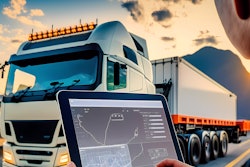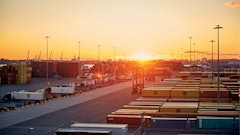
The food logistics industry is facing an increasingly volatile landscape, shaped by escalating trade wars and tariffs that are disrupting supply chains across the globe. Geopolitical tensions, including the ongoing war in Ukraine and instability in the Middle East, are straining the flow of essential food products like grain, oil and perishables.
Meanwhile, climate change and mass migration are creating new bottlenecks and challenges, particularly along the U.S.-Mexico border, further complicating food distribution. These disruptions are forcing food logistics companies to rethink traditional supply chain models, as once-dependable routes are being redrawn and global trade dynamics continue to shift.
The focus is set on finding new innovative solutions that enable businesses to overcome obstacles and optimize their operations. That includes developing and delivering locations services, routing, optimization and navigation solutions to help food companies navigate the evolving landscape.
Escalating geopolitical tensions are making global supply chains more complex than ever. These disruptions aren’t just logistical challenges; they signal a deeper shift in global trade, highlighting the need to reassess traditional supply chain models and prioritize resilience through technological innovation. In some cases, global supply chain disruptions can also serve as opportunities—paths to building stronger, more adaptable systems capable of withstanding future challenges if companies leverage the right tools and adopt a proactive, forward-thinking approach.
Food logistics at a crossroads
Organizations can no longer afford to rely on reactive strategies or outdated manual processes to manage disruption. Supply chain operations must evolve proactively, harnessing automation technology to boost efficiency, mitigate risk and better anticipate and respond to disruptions as they happen.
Over the past decade, companies have followed vastly different paths toward digitalization, largely due to the absence of universal standards for digital solutions. As a result, technology stacks often remain siloed, unable to communicate with one another. This lack of integration complicates the ability to accurately track orders and capacity, making it harder for businesses to ensure smooth operations.
Despite significant investment in transportation technology, trucking productivity has remained largely stagnant in recent years. The U.S. Department of Transportation’s data on trucking efficiency—measuring labor hours against output—has not shown the same improvements seen in other transportation modes. This stagnation isn't due to a lack of innovation, but rather the fragmented nature of many technological solutions.
In the food sector, these disruptions hit hardest. From shifting tariffs on imports of Mexican, Canadian and Chinese goods to new trade route challenges caused by climate change and migration, food logistics may be feeling the strain of geopolitical tensions faster than many other industries. Price increases on goods and tight inventory margins mean that supply chain delays or route diversions lead to heightened risks of spoilage, especially of perishable goods, loss of revenue and missed consumer demand.
Evolving tariffs and shifting regulations will continue to greatly impact the flow of essential food products, requiring companies in food logistics to rethink traditional approaches to sourcing, distribution, transportation and storage.
Collaboration fuels resilience
A standardized approach to digitalization, rooted in a collaborative network rather than isolated efforts, is the solution. A collaborative 'platform approach' enables a seamless integration of physical and digital systems, paving the way for a unified logistics network that spans the entire industry. By connecting shippers, carriers, logistics service providers and other stakeholders, communication is streamlined, real-time insights are gathered, administrative costs are reduced and efficiency is improved.
Furthermore, a platform approach facilitates better decision-making and problem-solving. Real-time data allows stakeholders to identify and visually track loads in transit to minimize the impact of issues related to product delivery or customer satisfaction.
Collaboration also facilitates data-driven decision-making, with companies gaining access to a wealth of insights that enable all parties to stay ahead. By leveraging this data, coupled with high levels of automation, companies can reduce dwell times and optimize yard operations. Over time, this data can be used to train AI models, create tools for autonomous procurement, real-time ETA predictions and more.
Final word: Don’t wait for the next crisis
Companies must do more than simply adapt—they must anticipate. Digital tools enable supply chain leaders and managers to proactively manage disruptions and respond with flexibility. To ensure a resilient supply chain that remains strong and prepared for future challenges and opportunities, businesses must be strategic and maintain a commitment to ongoing innovation.
A key to progress in 2025 is combining new and existing technologies to improve supply chain visibility, helping companies spot and fix bottlenecks in real time. By using smart networks and digital tools, organizations can better predict, respond to and recover from disruptions and plan for long-term growth.




















